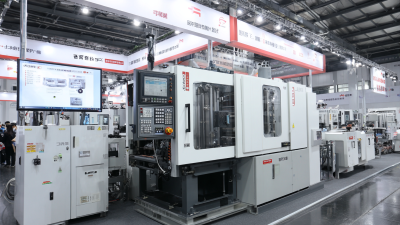Understanding the Future of Plastic Components in Sustainable Manufacturing Processes
As industries increasingly pivot towards sustainable manufacturing processes, the integration of plastic components has emerged as a critical focus area. According to a report by the Ellen MacArthur Foundation, the global plastic waste could reach 1.3 billion metric tons by 2040 if current trends continue, highlighting an urgent need for innovative solutions within the plastic lifecycle. The adoption of advanced recycling technologies and bio-based alternatives is essential to mitigate the environmental impact while ensuring high performance and cost-effectiveness. Furthermore, the International Plastics Data Committee notes that the demand for engineered plastics in sustainable applications is projected to grow by 4.5% annually, reflecting a shift towards eco-friendly materials that do not compromise on functionality. Understanding the evolving dynamics of plastic components in this context is crucial for manufacturers aiming to balance ecological responsibility with operational efficiency, thereby shaping a more sustainable future for the industry.

Innovative Materials: Exploring Biodegradable and Recyclable Plastics
The future of plastic components in sustainable manufacturing is increasingly focused on innovative materials, particularly biodegradable and recyclable plastics. According to a report by Mordor Intelligence, the global biodegradable plastics market is projected to reach approximately $6.5 billion by 2026, growing at a CAGR of around 20%. This growth is driven by increasing environmental concerns and regulatory pressures aimed at reducing plastic waste. Biodegradable plastics, made from renewable resources, can decompose in natural environments, offering a viable alternative to traditional petroleum-based plastics.
In addition to biodegradable options, recyclable plastics are also gaining traction. The Recycling Partnership reports that the U.S. recycling rate for plastics remains low, at about 9.1%. However, initiatives to enhance recycling processes and increase consumer awareness are vital. Companies that adopt closed-loop systems can reduce their reliance on virgin materials and contribute to a circular economy. Investing in designs that prioritize recyclability is becoming imperative for manufacturers aiming for sustainability.
Tips: When selecting materials for your manufacturing processes, consider those labeled as biodegradable or recyclable. Conduct Life Cycle Assessments (LCAs) to measure the environmental impact of materials from production to disposal. Collaborate with suppliers who focus on sustainable practices and can provide innovative material options that align with your sustainability goals.
Understanding the Future of Plastic Components in Sustainable Manufacturing Processes
Digital Transformation: The Role of AI and IoT in Sustainable Plastic Production
The integration of Artificial Intelligence (AI) and the Internet of Things (IoT) into sustainable plastic production processes marks a significant shift towards minimizing waste and enhancing efficiency. According to a recent McKinsey report, the adoption of these technologies can potentially reduce manufacturing costs by up to 30%, while also decreasing emissions by approximately 25%. AI algorithms can optimize production schedules, manage resource allocation effectively, and predict equipment maintenance needs, leading to reduced downtime and less plastic waste during the manufacturing process.

Furthermore, IoT devices enable real-time monitoring of production lines, providing valuable data on operational efficiency. A study from Gartner highlights that IoT applications in manufacturing can improve overall process efficiency by up to 20%. For sustainable plastic production, this means companies can track material usage with precision, allowing for more responsible sourcing and recycling of materials. As organizations strive to meet sustainability goals, the synergy between AI, IoT, and sustainable practices is paving the way for a more circular economy in the plastic industry, where materials are reused and repurposed, reducing reliance on virgin plastic production.
Lifecycle Analysis: Assessing Environmental Impact of Plastic Components
Lifecycle analysis (LCA) is a crucial tool in evaluating the environmental impact of plastic components in sustainable manufacturing processes. It examines every stage of a product's life, from raw material extraction through production, use, and eventual disposal. By focusing on these stages, LCA can identify critical areas where sustainability can be enhanced, particularly for plastic components, which often face scrutiny due to their perceived environmental footprint.
The assessment includes metrics such as energy consumption, greenhouse gas emissions, and potential toxicity. As manufacturers aim to reduce their carbon footprint, understanding these factors allows for informed decision-making regarding material selection and production methods. For instance, utilizing bio-based plastics or enhancing recycling programs can significantly mitigate adverse environmental effects. Ultimately, LCA not only fosters transparency in the use of plastics but also encourages continuous innovation in sustainable practices within the manufacturing sector, leading to a more environmentally responsible future.
Industry Collaboration: Building Partnerships for Sustainable Supply Chains
The future of plastic components within sustainable manufacturing processes hinges significantly on industry collaboration. Building strong partnerships between manufacturers, suppliers, and recycling companies is essential for creating a circular economy that minimizes waste and optimizes resource use. By fostering these collaborations, companies can share best practices, innovative technologies, and efficient supply chain strategies that enhance sustainability while maintaining competitiveness.
Moreover, collaborative efforts enable the development of standardized guidelines and certifications for sustainable materials and processes. This not only fosters transparency within the supply chain but also encourages businesses to shift towards eco-friendly alternatives. Through joint initiatives and shared R&D projects, organizations can collectively address challenges such as reducing plastic waste and improving recyclability. In this way, industry partnerships not only contribute to environmental sustainability but also drive economic growth by creating new market opportunities in the realm of sustainable plastics.
Future Trends: Predicting Plastic Innovations in Manufacturing Practices
The future of plastic components in sustainable manufacturing processes is poised for significant transformation, particularly as innovations emerge in various plastic markets. The paper straw market exemplifies this trend, expected to grow from a valuation of $71.934 million in 2023 to an impressive $360.451 million by 2032. This remarkable growth highlights the increasing demand for eco-friendly alternatives in manufacturing, as consumers and businesses alike seek sustainable solutions to address environmental concerns.
Similarly, the biodegradable covering film market is projected to witness substantial growth, with a compound annual growth rate (CAGR) of 8.5% anticipated from 2024 to 2030, rising from $1.3 million in 2022 to $2.5 million by 2030. This trend underscores the ongoing shift towards utilizing biodegradable materials in manufacturing processes, reflecting an industry-wide commitment to sustainability. As manufacturers embrace these innovations, the integration of advanced materials and sustainable practices will likely redefine plastic applications across various sectors, paving the way for a greener future.

Related Posts
-

Exploring Innovations in Plastic Injection Molds at the 2025 China Import and Export Fair
-

The Evolution of Stamping Dies in Metal Forming Industry Trends and Innovations
-

The Future of Micro Machining Technologies Driving Precision Engineering Innovations
-

Transforming Industries: Unleashing the Power of Cutting-Edge Industrial Applications
-

Unlocking Industry Potential with Plastic Mold Innovation at the 138th Canton Fair 2025
-

Understanding the Plastic Injection Moulding Process: A Comprehensive Guide for Beginners








